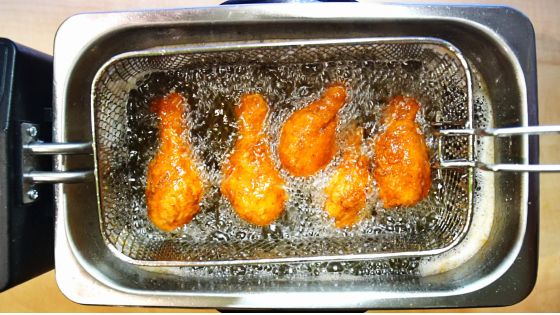Pressure frying is a cooking method that involves the use of pressure to cook food in hot oil, resulting in crispy and juicy fried foods. This technique has become increasingly popular among professional chefs and home cooks alike for its ability to produce perfectly cooked dishes in a short amount of time. However, mastering the art of pressure frying can require some trial and error, as well as knowledge of specific tips and tricks.


In this article, we will explore the basics of pressure frying, including how it works and what types of foods are best suited for this cooking method. We will also delve into key tips and techniques for achieving delicious results every time you fry using a pressure cooker. By understanding these principles, home cooks can elevate their kitchen skills while enjoying the many benefits of pressure frying.
Understanding Pressure Frying
Pressure frying is a cooking technique that has been around for many years, and it involves using pressurized steam to cook food. This method of cooking is particularly popular in fast-food chains as it allows the preparation of fried foods quickly without compromising on quality. The pressure cooker heats up, creating steam inside which cooks the food faster than traditional frying methods.
The process of pressure frying can be complicated, but once you understand how it works, it becomes much easier to master. One of the critical aspects of this technique is getting the temperature right. If the oil temperature is too low or high, then your food may not turn out as expected. Additionally, overcooking under high-pressure conditions may result in dryness or even burnt flavors.
Another thing to keep in mind when considering pressure frying is safety measures. Pressure fryers are designed with safety features such as release valves and locking mechanisms to prevent explosions due to excessive build-up of internal pressure. It’s essential to follow manufacturer instructions carefully and take necessary precautions while using a pressure fryer to avoid accidents that could cause harm or damage. Understanding these basic concepts will help you make informed decisions about whether pressure frying suits your culinary needs and preferences.
Moving forward, let us look at choosing the right foods for pressure frying; we’ll explore some tips and tricks that come in handy when selecting ingredients suitable for this cooking technique.
Choosing The Right Foods For Pressure Frying
As we delve deeper into the art of pressure frying, it is important to understand that not all foods are created equal when it comes to this cooking method. While pressure frying can produce delicious and crispy results, certain types of food may not hold up well under high pressure and heat. Therefore, selecting the right foods for your pressure fryer is essential for achieving optimal results.
One key factor to consider when choosing foods for pressure frying is their moisture content. Foods with a higher water content, such as fruits or vegetables, may become too soggy or lose their texture when subjected to intense heat and pressure. On the other hand, protein-rich foods like chicken or fish tend to fare better in a pressure fryer due to their ability to retain moisture while still crisping up on the outside.
Another consideration when selecting foods for pressure frying is their size and shape. Larger items may take longer to cook through properly under high pressure, which could lead to unevenly cooked food or even burns. Additionally, odd-shaped items like wings or drumsticks may require more attention during cooking to ensure they are evenly coated in oil and cooked thoroughly.
To achieve perfect results every time you use your pressure fryer, preparing it correctly beforehand is crucial. This includes ensuring that all components are clean and free from debris, as any leftover residue can affect the quality of your fried food. In addition, making sure that your cooker has reached its proper temperature before adding your chosen ingredients will help them cook more evenly and result in crispier textures overall. By following these steps and taking care in selecting the right foods for your machine, you can unlock endless possibilities for flavorful dishes using the art of pressure frying!
Preparing Your Pressure Cooker For Frying
To prepare your pressure cooker for frying, you must first ensure that it is clean and free of any debris or leftover food particles. This will help prevent burning and contamination during the cooking process. Additionally, make sure to check the gasket and release valve to ensure they are in good working condition.
Next, add enough oil to the pressure cooker until it reaches about one-third of the way up the sides. It’s important not to overfill with oil as this can cause dangerous splattering when under pressure. Heat the oil on medium-high heat until it reaches a temperature between 350-375°F.
Once the oil has reached optimal frying temperature, carefully lower your prepared food into the hot oil using tongs or a slotted spoon. Close the lid securely and allow pressure to build according to your specific cooker’s instructions before beginning to time your cook. With these steps completed successfully, you’re now ready to move onto techniques for achieving perfectly fried food without sacrificing flavor or texture.
Techniques For Achieving Perfectly Fried Food
Achieving perfectly fried food requires mastery of specific techniques in the kitchen. One technique is to ensure that the oil temperature is at an optimal level before frying. If the oil temperature is too low, it will cause your food to absorb more oil and result in soggy or undercooked food. On the other hand, if the oil temperature is too high, your food may burn on the outside while remaining uncooked inside.
Another important technique for achieving perfect fried foods is ensuring that you use a suitable type of flour or batter for coating your ingredients before frying. The right choice of coating can make all the difference when pressure frying as it helps to create a crispy outer layer with a soft and moist interior. For example, using cornstarch creates a thin and delicate crust whereas tempura batter produces a thicker and crunchier crust.
Lastly, an essential technique for getting perfectly fried foods is maintaining consistent heat levels throughout cooking. Consistent heat ensures even cooking and browning of your ingredients without burning them. To maintain consistent heat levels while pressure frying, avoid overcrowding your pan and leave enough space between each piece of ingredient so they don’t touch each other during cooking.
With these essential techniques mastered, you’re well on your way to creating deliciously crispy and perfectly cooked dishes every time! However, sometimes things go wrong in the kitchen leading to common issues which need troubleshooting solutions.
Troubleshooting Common Pressure Frying Issues
Pressure frying can be an intimidating and complicated process for any cook. Despite its numerous benefits, such as reduced cooking time and enhanced flavor, pressure frying issues are not uncommon in the kitchen. However, with a few simple troubleshooting tips and tricks, these problems can easily be addressed.
One common issue that arises during pressure frying is uneven browning of the food. This often occurs due to overcrowding or insufficient oil coverage. To resolve this problem, ensure that your food pieces are evenly sized and spaced apart from each other before adding them to the fryer basket. Additionally, make sure there is enough oil in the fryer to cover all the food entirely; otherwise, rotate your items halfway through cooking.
Another frequent problem is undercooked or overcooked food. Undercooking results from inadequate heat levels or short cooking times while overcooking stems from excessive temperatures or long exposure to heat. The solution here is to keep an eye on the temperature gauge regularly and adjust it accordingly throughout the frying process. Also, pay close attention to recommended cooking times provided by manufacturers or recipes when determining how long to fry your food.
Finally, some cooks may encounter difficulties handling high-pressure situations when using their pressure cooker for deep-frying purposes. It’s crucial always to follow safety guidelines provided by manufacturers strictly. Ensure that you allow adequate depressurizing time after turning off the stove burner before opening up your cooker lid cautiously. Be especially mindful of steam burns since they could cause severe injuries if handled carelessly!
In summary, troubleshooting common pressure frying issues involves paying careful attention to factors like evenness in size spacing out ingredients well enough so they don’t crowd one another too much healthy amounts of oil applied correctly according to recipe specifications following proper heating methods staying alert about safe practices around hot liquids maintaining awareness regarding potential hazards at all times – doing so will set you up for success every time!
Conclusion
Pressure frying is a cooking technique that can produce delicious and crispy fried foods. It involves using a specialized pressure cooker to fry food under high pressure, which locks in moisture and creates a crisp exterior. However, achieving the perfect result requires careful attention to detail.
To begin with, it is important to choose the right foods for pressure frying, as not all ingredients are suitable for this method of cooking. Additionally, preparing your pressure cooker correctly and mastering various techniques such as adjusting temperatures and managing oil levels will ensure perfectly fried food every time.
Despite being an art form in itself, there may be some issues while trying out the art of pressure frying, but troubleshooting these common problems will help you create amazing dishes without any fuss. In conclusion, mastering the art of pressure frying takes practice, patience and skill; however, once accomplished it opens up avenues for creating culinary delights that have texture and flavor combinations unparalleled by other methods of cooking. Pressure frying has gained popularity over recent years because its ability to cook quicker than conventional deep-frying whilst retaining flavors makes it ideal for both home cooks and professional chefs alike. So why not give it a try?
























